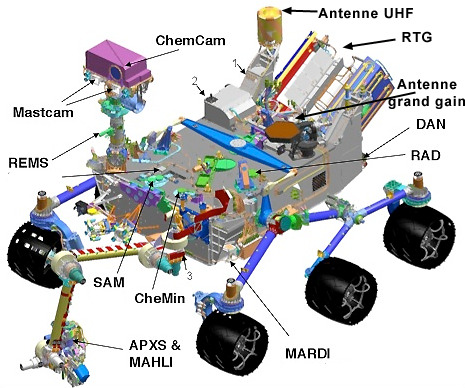NASA's Curiosity Is Biggest Mars Mission Yet (In More Ways Than One)
Safely landed on Mars, NASA's Curiosity rover dwarfs its robot predecessors by a factor of 2:1, though we'll need to wait for it to take off its lenscap before we get a proper look at the Martian surface. Measuring 3m long, the six-wheeled Curiosity is double the size of the previous Exploration rovers and uses its heft to carry fifteen times heftier instruments with which it will check for evidence of life on the red planet.
In fact, Curiosity is five times heavier than previous landers, and – as the group photo above shows – is more akin to a small car than the human-scaled rovers that came before it. Altogether, that has allowed for equipment of the sort never before taken to Mars: Curiosity carries a laser that can check out the elemental composition of distant rocks, for instance, while close-up testing is done by loading an internally-carried lab with samples gathered up by a robotic arm.
First step, however, will be orienting Curiosity and gathering some photos for the album. The first batch of shots already sent back to Earth are comparatively low-resolution, since they were taken with the so-called "Hazcam"; in contrast, the two main cameras will grab full color 1600 x 1200 stills (or 720p video at 10fps), but will only be operation when the "head" of the rover is unpacked and extended.

At that point, the Hazcams – of which there are four, at the extremes of the rover – will be used for autonomous navigation, building a 3D perspective of the environment around Curiosity and its robotic arm. There are seventeen cameras in total, spanning visible light through more specific purposes depending on the scientific intention.
NASA expects the Curiosity mission to last two years, though it's possible the rover could outlast its original estimates. The last Exploration rover, "Opportunity", recently woke from its fifth winter to continue trundling around Mars.
There's more on the "7 minutes of terror" process of landing Curiosity on Mars in our full SlashGear 101 on the subject. With transmission delays back to Earth amounting to around fourteen minutes, and the landing itself taking roughly half that time, the entire process had to be automated as there was no way for it to be manually remote-controlled.
